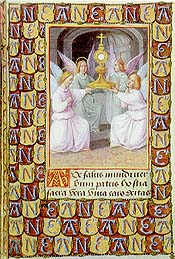
Week 4: Church and People
 |
DISCUSSION GROUP
Week 4: Church and People |
These are the issues you should think about this week:
1. What challenges did the papacy face during the later
Middle Ages?
2. What impact did these have on its authority?
3. How did the Church disseminate instruction on the
faith to the laity?
4. What particularly did the Church want the laity to
know?
5. How did the laity respond to the Church's teaching?
6. How far do you suppose were the laity enthused by
late medieval Catholicism?
The document is most obviously concerned with questions 3 and 4 and less directly to 5 and 6.
Mirk's Festial was compiled in the mid C15 for use by parish priests by John Mirk, a canon (priest) and sometime prior of the Augustian abbey of Lilleshall in Shropshire. Augustian monasteries often supplied their own canons to serve as priests for the various parish churches they had appropriated (ie gained control of, including the income from tithes etc), so Mirk may have had a practical interest in providing instruction for priests ministering to the laity. The document represents suggested material for inclusion in regular parish worship for the third Sunday before Ash Wednesday. Note that the text in English rather than Latin.
What is the reason for Mirk beginning with Holy Church?
What may we surmise from the reference to Christmas festivities?
What significance does Mirk see in Christmas?
In the paragraph beginning 'For these reasons ... ' and
the two paragraphs following, what aspects of teaching is Mirk reinforcing?
Mirk goes on to relate a story (or rather three different
stories).
What does Mirk refer to as prompts for his 'story'?
Where do these stories come from and how are the points
made?
The first part, about a king, implicitly reinforces the
idea of monarchy as part of the divinely ordered scheme of things, but
it is not a subject that ordinary parishioners could readily identify with.
The same is not true of the next part.
What can we read out of the paragraph beginning 'The
other ointment ...'? Do you suppose the Statute of Labourers / labour shortage
may have had any influence on Mirk's thinking / text?
What might Mirk's audience / congregation have learnt from his telling of the Fall (the story of Adam and Eve, and the expulsion from the Garden of Eden)?
The final story agian relates to Adam and Eve.
What point is Mirk making by juxtaposing these two different
stories?
What is Mirk doing in the final paragraph?
Return
to Main Page
Return
to document [part II, no. 5]